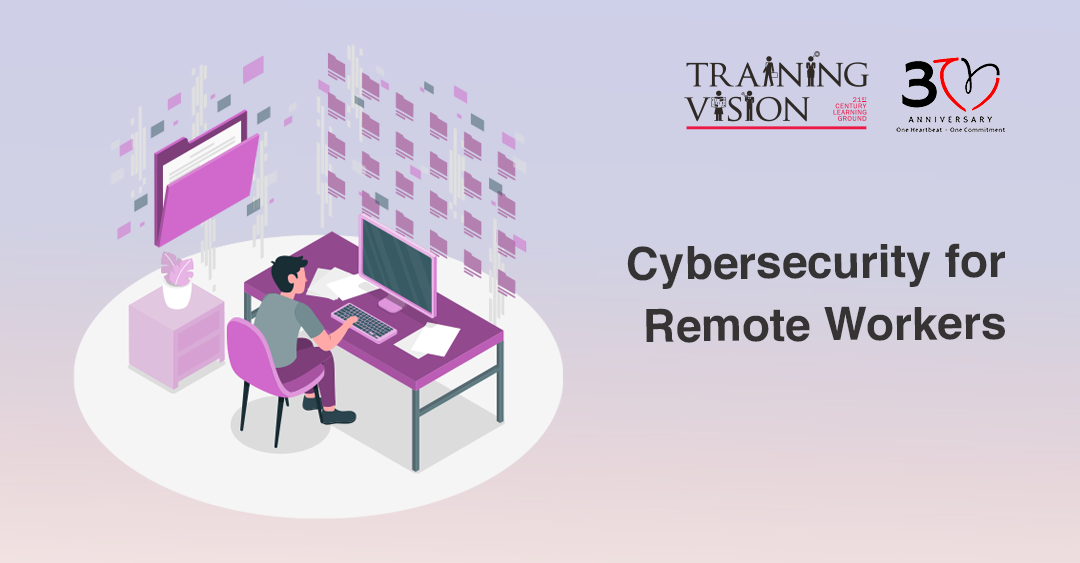The Covid-19 pandemic has made remote working more relevant than ever before, in all parts of the world. With employees getting the hang of it and becoming more productive (probably more than they are in the office setting), most companies are allowing them to stay working remotely. Advantages of remote working include increased productivity, flexibility, and work-life balance, and while all of these sound lovely to achieve, this practice cannot come without any disadvantage at all. Cybersecurity risks are just one, but probably the most challenging downside to it.
The remote working setup has presented a greater concern when it comes to cybersecurity.
Cybersecurity risks of working from home
Remote working is not exactly popularised by the pandemic—there are companies that allow some of their employees to work from home even before the Covid-19 era, and there are also employees who have to go on business trips from time to time. Being off-site and out of bounds of the cybersecurity system of the company, it is far more challenging to take care of their cyber safety.
Here are some of the common cybersecurity risks of people working remotely.
Basic physical security practices are not observed. Imagine you are in a café or a restaurant talking on the phone with your boss about business matters. It helps a lot when you lower your voice and not allow everyone to hear what you’re going to say. Other people do not have to know what you’re doing, and you certainly do not want potential hackers to hear what kind of client information your company has in possession. Your laptop screen does not have to be exposed as well for all the people to take a peak.
Weak passwords are still a thing. Creating strong passwords have been taught to us ever since the internet began. Not everyone can remember a password that has a lot of special characters in it so some people store their passwords where they can get caught lying around which actually defeats the purpose.
Accessing sensitive data through an unsecured wifi connection. Employees working from home have to access their home network which is highly vulnerable to hacker exploitations and cybercrimes. Higher risks go to those who are travelling for work, as they need to use the public wireless network. Hotspots in coffee shops, restaurants, airports, and malls expose users might be very useful that business owners are doing a favour to their clients but it could be that network security is the least of their priorities.
The most common threat in this setting is the Man-in-the-Middle attacks (MitM). This is a form of eavesdropping that happens during data transmission. For example, when a computer connects to the internet, data is sent from Point A (computer) to Point B (website). Attackers would get in between these points and gather information from the transmitted data.
Using personal devices for work-related activities. Work computers are usually configured to meet certain security requirements that personal computers do not have. However, most organisations are not prepared for the work-from-home setup they allowed employees to use their personal devices. Some employers even implemented the BYOD (Bring Your Own Device) Policy without a concrete plan on how to maintain company security.
Personal devices are vulnerable to cyberattacks in so many ways. While lost and stolen devices can implicate much bigger problems, not everyone is keen on updating their software. This makes sensitive data accessible to hackers. Plus, if the hackers are after the company data, why not gather some personal data while they are there, right?
Unencrypted file sharing happens more often than not. Employees share sensitive files and private data all the time—from client account information to company information which is a lot of fortune for cybercriminals. While encrypting stored data is a good practice, it is also not a bad thing to remind employees to encrypt the files they are sending to lessen the chance of being intercepted while it is in transit.
Remote working best practices
Working from home exposes employees to a lot of cyberattacks but this does not mean there is nothing that can be done to prevent these malicious attacks. Basic safety measures can go a long way, and if done on a regular basis, they can keep you and your data safe and secured.
Here are some of the best practices that can be done.
Enhance your home wireless network security. It is always best to take extra precautions even in your home wireless network. Usually, we would just change the password of our wi-fi connection to prevent our neighbours from accessing our network and controlling our data. Now that we are working from home and it might be the case for a while, it’s time to take additional precautionary measures. Updating the router firmware, updating the router administrator login credentials, and using a guest network for your visitors are just some of the basic steps you can take to ensure the security of your home network.
Invest in a VPN. One of the most essential elements of keeping data and personal information safe is using a VPN. This is especially true when you are using less secure networks like Wi-Fi in coffee shops, hotels, and airports. While you’re at it, you might also want to use a VPN that provides multi-factor authentication as it adds more levels of security. Multi-factor authentication is also recommended in accessing sensitive data and private information.
Update your passwords frequently. This is extremely useful, regardless of whether it is for work or personal accounts that need passwords as protection. There are some accounts of software that reminds you, or even requires you to update your passwords every three months or so and make sure to take advantage of that. Password generators are recommended to create strong ones but if they seem to be a bit complicated to memorise, try to come up with something that’s a combination of letters, numbers, and special characters.
Keep your software and operating systems updated. Updates, especially that of the operating system can take several minutes and most of us do not have the patience or even the time to do so. However, it is extremely important that we take this step whenever necessary because outdated versions of software have potential vulnerabilities which can make it easier for hackers and cybercriminals to do their job.
Keep work data on work computers as much as possible. Huge organisations have efficient IT teams which may have installed security updates on your work computers. While using multiple devices at work can help increase your efficiency and productivity, you may be exposing your work data to risk by using your personal devices for work matters. Always make sure that you are using your work computer in accessing sensitive work data.
Cybersecurity for companies in 2022
Most companies these days have a chunk of their workforce in the remote setup, and it looks like the situation is not going to change anytime soon. Thus, it is time to dust off and update their cybersecurity system. Here are some of the security measures organisations can follow.
Enforcing a data security policy. Intentional internal security breaches can happen anytime, but we all know it is more likely that an employee could just carelessly handle sensitive data by mistake. Create a policy document that clearly states the security protocols that employees need to comply with, along with the consequences in the cases of non-compliance. It also helps to explain to the employees the importance of their compliance. Have them sign the document and make sure to hold them accountable for it.
Provide the right tools and technology to your employees. Now that the employees are bound to comply with the company’s cybersecurity policies, the organisations must ensure that their workers have the right tools and the technology to remain compliant. VPN, password manager, and anti-virus software are just some of the basic cybersecurity tools that can prevent breaches and cyber threats.
Always update the company’s network security systems. Firewalls, anti-virus software, and spam filtering tools are nice must-haves in employee devices, thus it is vital that these are frequently updated. Outdated software can cause vulnerabilities and therefore it is more prone to threats.
Control the use of personal devices. There are organisations that implement the BYOD (Bring Your Own Device) policy. While this can help with the employees’ productivity and efficiency, this can potentially expose sensitive data to threats, as personal devices do not have enough security features.
Conduct cybersecurity training for employees and provide uncompromising IT support. In the end, none of these will be effective if employees are unaware of the objectives of these measures. Robust security measures start with proper training and awareness, thus make sure to conduct these. Also, make sure that the IT department is always available to provide assistance to remote workers with cybersecurity-related concerns.
Remote working is here to stay, and companies are left with either starting to adjust their policies and upgrade their systems or be ultimately left behind. As remote working proves to increase productivity, organisations should also make sure that they have a cybersecurity infrastructure robust enough to protect their workforce from cyber threats and other related issues.
As more and more companies continue to strengthen their digital fortress, you might be interested in starting your career in cybersecurity. Sign up for our Advanced Diploma in Cyber Security (Advanced Standing) and gain foundational knowledge in info-comm technology and cybersecurity training that can help you kickstart a career in the realm of modern technologies.
Not sure which cybersecurity job you’d like to start with, check out our blog post on jobs in cybersecurity.








